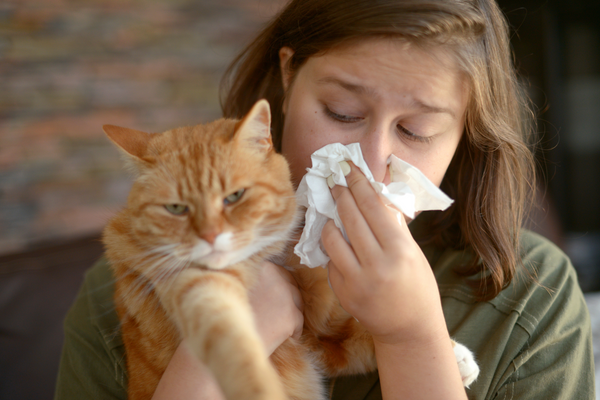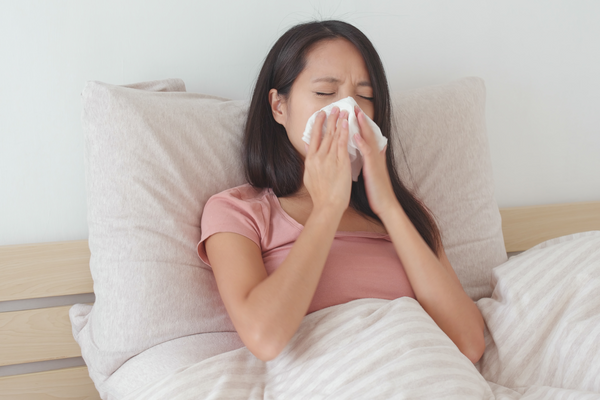Winter Allergies: What Causes Them and How You Can Find Relief

Spring and fall are notorious for triggering allergies due to the wide variety of flowers, trees, grasses, and other plants that release high levels of pollen. These seasonal allergies usually end with the first hard freeze in cooler climates. However, if you’re having allergy symptoms during wintertime, no matter the climate, the culprit is likely indoor allergens.
The three most common indoor allergy triggers are dust mites, pet dander, and mold, and they can prompt a host of awful symptoms, from a runny nose and sore throat to sneezing and itchy eyes. Knowing how to avoid or minimize triggers can help keep you feeling your best all winter long. We have the inside scoop for you here.
Winter Allergies, Cold, Flu, or COVID-19 (Coronavirus)?
During the winter, it can be challenging to distinguish allergy symptoms from a cold, influenza (flu), or even COVID-19 since the conditions can all share signs and symptoms such as congestion, cough, and runny nose. However, colds, the flu, and COVID-19 are viral infections, while an allergy is your body’s immune system response to an irritant or trigger.
However, most viral infections don’t usually last more than a couple of weeks, while allergies will continue as long as the allergen is present. And symptoms like itchy, watery eyes are typically a sign of an allergy, not a viral infection, while fever, nausea or vomiting, and diarrhea are not associated with allergies. A cough sometimes comes with allergies but is more commonly a sign of a viral infection.
NOTE: If you have signs or symptoms of COVID-19, it’s important that you contact your doctor or clinic right away for medical advice.
What Causes Winter Allergies?
More than 50 million Americans experience allergies each year, and many suffer year-round allergy symptoms caused by indoor allergens. When these symptoms occur year-round, the condition is called perennial allergic rhinitis or nasal allergies. The word rhinitis means “inflammation of the nose.” In addition to causing allergy symptoms, allergens can also trigger asthma flare-ups in people with allergic asthma.
Spending more time indoors during the winter months can make you more vulnerable to indoor allergens. According to the American Academy of Allergy, Asthma, and Immunology (AAAAI), the most common indoor allergens that may trigger symptoms in the winter include:
Pet Dander
Contrary to popular opinion, there are no “hypoallergenic” breeds of dogs or cats. That’s because it’s not the fur people are allergic to, but to an allergen found in the saliva, dander (AKA dead skin flakes), or urine of an animal with fur.
Related: Allergic to Your Pet? Easy Tips to Prevent & Control Your Allergy
Indoor Mold
Mold spores constantly move through the air, both inside and outside the home. While we all breathe in mold spores at some time or another, those with an allergy to mold can have a host of negative symptoms when exposed, like sneezing, congestion, and itchiness. Mold and mildew favor damp areas, like bathrooms and basements.
Dust Mites
These microscopic creatures are the most common cause of year-round indoor allergies, according to the Asthma and Allergy Foundation of America (AAFA). While dust mites can be found throughout the house (and live in even the cleanest of homes), they thrive in warm, humid environments like bedding, carpeting, and upholstered furniture.
Related: How to Easily Reduce Dust Mites In Your Home
Cockroach Sheddings & Droppings
Cockroaches live in all types of buildings and all kinds of neighborhoods. Having these pesky critters lurking doesn’t mean you have a dirty home. In fact, the National Pest Management Association reports that 63% of homes in the U.S. contain cockroach allergens. That number rises to between 78% and 98% of homes in urban areas. According to the American College of Allergy, Asthma, & Immunology (ACAAI), cockroaches’ saliva, feces, and shedding body parts can trigger asthma and allergies.
What You Can Do to Help Prevent Winter Allergies
Another major issue for people with winter allergies who live in colder climates is that the cold-weather lifestyle can turn a simple (but annoying) allergic reaction into something much worse. When you turn up the heat inside your home, for instance, your indoor air becomes much drier. This drier air can lead to dry noses, nosebleeds, and skin cracking – which, in turn, boosts infection rates of secondary viral infection when a person’s nasal passages are already inflamed from allergies.
It may not be possible to eliminate winter allergies entirely, but you can reduce exposure to allergens and neutralize their threat within your home. Here are some tips to help those suffering from winter allergies find some relief:
- Use a humidifier to reduce dryness in the air, but avoid turning your home into a rainforest: Dust mites thrive in humidity over 60% and temperatures of 60F – 85F. Mold also grows faster in high humidity. A maximum humidity of around 50% in the winter can help reduce dry air. Just be sure to frequently clean and disinfect the humidifier’s tank with Vital Oxide to prevent mold and bacteria buildup.
- Wash bedding and washable throw rugs weekly with The Ecology Works Anti-Allergen Laundry Detergent to remove and neutralize allergens from dust mites, pet dander, molds, and more.
- Vacuum carpets, rugs, and upholstery frequently (at least once a week), using a vacuum with a high-efficiency particulate (HEPA) filter.
- Indoor molds and mildew need dampness typically found in basements, bathrooms, or anywhere with leaks. First things first, address any leaks. Next, remove mold from surfaces and treat with Vital Oxide. Then, dry the area thoroughly. If mold covers an area of more than 10 square feet, consider hiring an indoor environmental professional.
- To minimize pet dander, bathe pets regularly with The Ecology Works Anti-Allergen Pet Shampoo.
- If you notice cockroaches around your home, start by blocking off any areas where they can enter, including crevices, wall cracks, and windows. Just like mold, roaches need water to survive, so fix any leaks that could unknowingly give cockroaches access to water. Keep food containers and garbage cans sealed. Vital Oxide removes allergens from cockroaches (as well as dust mites, pet dander, and molds) and is safe for use on surfaces that water won’t harm; use it to clean all around the home. Consult an exterminator if you believe you have a cockroach infestation.
- Change air filters frequently during the winter months. Forced-air furnaces circulate airborne dust containing lint, animal dander, bacteria, fabric fiber, and food materials. HEPA air filters can help capture more irritants and allergens.
- Up your cleaning game to combat indoor allergens by dusting at least twice a week. Rather than using a dry dusting method that can cause allergens to go airborne, use a damp microfiber cloth to remove dust from furniture, shelves, windowsills, and other dust-prone areas around your home. For extra allergen-busting power, reach for The Ecology Works Anti-Allergen Solution. You can either spray it directly onto hard surfaces after cleaning to neutralize allergens from dust mites and pet dander, or spray it onto a microfiber cloth and wipe. This solution can be used on both hard and soft surfaces (including bedding, carpets, upholstery, and pet beds). The Anti-Allergen Solution renders common household allergens harmless to allergy sufferers.
- Consult your doctor or allergist to determine what’s causing your allergy or asthma symptoms; an allergy test will confirm what triggers your allergic symptoms.
Have questions about reducing allergens or irritants inside your home or business? We have answers! The Ecology Works has been helping folks with allergies and asthma since 1993. We can help you select the products you need to live a better, allergen-free life. Please feel free to Contact Us or message us on Facebook. No question is too small! We're here to help.




